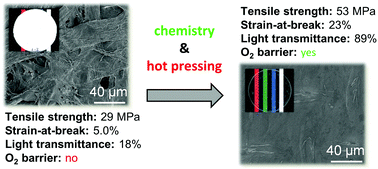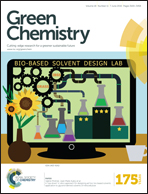Towards natural-fibre-based thermoplastic films produced by conventional papermaking†
Abstract
Materials based on cellulose are predicted to be of great importance in a sustainable society. However, for materials such as paper to replace materials with a higher ecological footprint, they need to be strong, ductile, provide a gas barrier, and, sometimes, also be transparent. Improved properties, or even novel properties, are also important for use outside the conventional markets. This paper describes how cellulose fibres partly derivatised to dialcohol cellulose can be used to fabricate high-density materials by conventional papermaking techniques that simultaneously display all the above-mentioned features. The materials produced were characterised with respect to X-ray diffraction, dynamic mechanical thermal behaviour, visual appearance, oxygen permeability and tensile properties. The highest degree of modification studied, resulted in a material with thermoplastic features, a tensile strength of 57 MPa, a strain-at-break of 44% and an oxygen permeability at 80% RH of 23 ml μm (m2 kPa 24 h)−1. At a thickness of 125 μm, these films have a total light transmittance of 78% (87% haze). However, by hot pressing the film for 2 min at 150 °C under a pressure of 16 MPa, and thereby increasing the density, the total transmittance increases to 89% (23% haze). The hot pressing can also be used to fuse individual pieces together, which is useful in many modern packaging applications. Altogether, this work shows how chemical modification of cellulose fibres can be used to induce novel properties and improve the range of application, and consequently provide an interesting bio-based material with a good potential to replace less sustainable materials.


 Please wait while we load your content...
Please wait while we load your content...